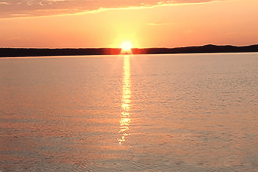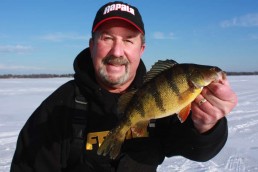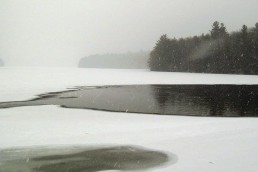Late-winter Browns: An Evening Feeding Frenzy
SHARE THIS POST
The sun was dipping toward the western horizon when I arrived at the lakefront. Although I usually like to fish for brown trout in the morning, dusk can be a productive time, too. As I pulled my gear out of the car, another fisherman was preparing to leave. He said he had not caught anything, but he had lost three fish. According to him, the fish were biting very lightly and he couldn’t keep them on the line.
The sky was clear, but the air temperature was only about 25 degrees. I walked out to the warm-water discharge and saw that there was only one other fisherman there. He was doing very well, and had already landed three brown trout and a relatively small steelhead. I could see that he was using spawn sacks for bait; unfortunately I had only brought artificial lures.
I tied a small gold Mepps Syclops spoon to my line and started fishing. It wasn’t long before I had a solid strike, and then another. I was having trouble hooking the fish, too. After 30 minutes the other angler caught another brown trout to finish his limit of five fish, so he left.
It was starting to get dark, and I still had not caught a fish. I started experimenting with different spoons and spinners of various sizes and colors, but I still couldn’t get any action. I moved into the spot vacated by the other guy (where the current was strongest), and quickly caught a coho salmon on a #2 silver-bladed Aglia spinner.
After I landed that fish, I couldn’t seem to get another hit on the spinner. It was almost dark, and I was anxious to find bait that the fish were interested in. I tied on a small minnow-shaped plug and cast it out into the current. I immediately had an arm-jerking strike. I hooked that fish solidly and battled him for several minutes in the heavy current.
The fish swam into the slack water at the side of the discharge where I was finally able to net him. He was a chunky 4-pound brown trout, and I quickly put him on the stringer with the coho. The sun had disappeared, but the last light of dusk still faintly illuminated my fishing spot.
I hoped that I had finally found the bait the fish wanted, so I cast it back out into the current. I retrieved it a foot or two, but then let it hover in the current. It had only been out there working for a minute when it was nailed by another hungry fish. This was only a 2- or 3-pounder, so I quickly landed it and added it to the other two fish on the stringer.
The light was nearly gone when I picked my rod up again and made another cast. Wham. Another fish grabbed the bait almost as soon as it hit the water. The action had suddenly turned red hot! This fish put up a very good fight, but in the end I slipped the net under him. It was another brown trout in the 3- to 4-pound range.
Are you enjoying this post?
You can be among the first to get the latest info on where to go, what to use and how to use it!
Now it was dark and it was really starting to get cold. I strung that fish and lifted my rod again, but this time I was going to let the lure float out in the current. I dropped the bait into the water near my feet and started to let the line out slowly. I had only stripped off a few feet of line when another good fish slammed the bait. I could hardly believe it.
This was a much bigger fish, and it was already leaping out of the water and thrashing right in front of me before I knew what was happening. The fish plowed out into the current, taking line and splashing like crazy. I fought him for a minute or two and then got a good look at him as he came up and wallowed near the surface. It looked like a 10-pound brown trout, and I suddenly got worried that I might lose him. Luck was on my side, however, and a couple of minutes later I netted him.
Prime low-light conditions
Fishing for Great Lakes brown trout at this time of the year can be very productive. Limit catches are not made every day, but with the right amount of preparation, chances for success are pretty good. Brown trout are not the only species that might be caught, either. Coho salmon, steelhead trout and lake trout can also be taken.
One of the things to consider when planning a brown trout excursion is what time of day to go. Although brown trout can be caught from shore on sunny days, it is generally much more productive to fish for them under low-light conditions. Browns are more sensitive to sunlight than some of the other Lake Michigan species, so try to get to the lakefront either very early or very late in the day.
Early morning has traditionally been among the best times to fish for browns. Many anglers actually arrive and start fishing under cover of darkness in areas where it is allowed, and that is a very good idea. Brown trout that have been swimming around and feeding all night are still on the prowl, and many are caught by fishermen first thing in the morning. Dawn is always a good time to fish, and as the sky begins to brighten, the fish often go on a feeding binge.
Late evening is another good time to fish. Brown trout are nocturnal fish, so this is the time of day that they start becoming active. If you have the time and inclination, keep fishing after the sun goes down. Some of the largest brown trout of the year are caught at night.
Low-light conditions do not only occur early in the morning or at night, however. Cloudy days are very productive times to catch wary brown trout. Snow-laden clouds often pave the way for a brown trout feeding frenzy. Some of the best fishing of the winter can occur during late-winter or early-spring snowstorms, so give it a try.
MWO
SHARE THIS POST
Did you enjoy this post?
You can be among the first to get the latest info on where to go, what to use and how to use it!
Tom Berg
A lifelong outdoorsman and award-winning outdoor writer and nature photographer, Tom Berg has been the Executive Director/Treasurer of the Hoosier Outdoor Writers group for the past 14 years. When he is not writing, he would rather be outside fishing, hunting or trapping than doing just about anything else.




